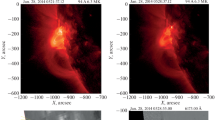Abstract
It has been controversial whether the flare-associated hard X-ray bursts are thermal emission or non-thermal emission. Another controversial point is whether or not the associated microwave impulsive burst originates from the common electrons emitting the hard X-ray burst.
It is shown in this paper that both the thermal and non-thermal bremsstrahlung should be taken into account in the quantitative explanation of the time characteristics of the hard X-ray bursts observed so far in the photon energy range of 10–150 keV. It is emphasized that the non-thermal electrons emitting the hard X-rays and those emitting the microwave impulsive burst are not common. The model is as follows, which is also consistent with the radio observations.
At the explosive phase of the flare a hot coronal condensation is made, its temperature is generally 107 to 108K, the number density is about 1010 cm−3 and the total volume is of the order of 1029 cm3. A small fraction, 10−3–10−4, of the thermal electrons is accelerated to have power law distribution. Both the non-thermal and thermal electrons in the sporadic condensation contribute to the X-ray bursts above 10 keV as the bremsstrahlung. Fast decay of the harder X-rays (say, above 20 keV) for a few minutes is attributed to the decay of non-thermal electrons due to collisions with thermal electrons in the hot condensation. Slower decay of the softer X-rays including around 10 keV is attributed to the contribution of thermal component.
Similar content being viewed by others
References
Acton, L. W.: 1968, Astrophys. J. 152, 305.
Akabane, K.: 1956, Publ. Astron. Soc. Japan, 8, 173.
Akhiezer, A. I. and Berestetskii, V. B.: 1965, Quantum Electrodynamics, Interscience Publishers, New York.
Anderson, K. A. and Winckler, J. R.: 1962, J. Geophys. Res. 67, 4103.
Arnoldy, R. L., Kane, S. R., and Winckler, J. R.: 1967, Solar Phys. 2, 171.
Arnoldy, R. L., Kane, S. R., and Winckler, J. R.: 1968, Astrophys. J. 151, 711.
Bruzek, A.: 1964, AAS-NASA Symposium on the Physics of Solar Flares (ed. by W. N. Hess), U.S. Government Printing Office, p. 301 (see, July 21 event, p. 318).
Chubb, T. A., Kreplin, R. W., and Friedman, H.: 1966, J. Geophys. Res. 71, 3611.
Cline, T. L., Holt, S. S., and Hones, Jr. E. W.: 1968, J. Geophys. Res. 73, 434.
Covington, A. E. and Harvey, G. A.: 1961, Phys. Rev. Letters 6, 51.
Frost, K. J.: 1964, AAS-NASA Symposium on the Physics of Solar Flares (ed. by W. N. Hess), U.S. Government Printing Office, p. 139.
Heitler, J. W.: 1954, The Quantum Theory of Radiation (3rd ed.), Clarendon Press, Oxford, p. 245.
Kawabata, K.: 1960, Rep. Ionosphere Space Res. Japan 14, 405.
Kawabata, K.: 1966, Rep. Ionosphere Space Res. Japan 20, 118.
Maxon, M. S. and Corman, E. G.: 1967, Phys. Rev. 163, 156.
Spitzer, L.: 1962, Physics of Fully Ionized Gases (2nd ed.), Interscience Publishers, New York, p. 131.
Takakura, T. and Kai, K.: 1966, Publ. Astron. Soc. Japan 18, 57.
Takakura, T.: 1967, Solar Phys. 1, 304.
Takakura, T., Uchida, Y., and Kai, K.: 1968, Solar Phys. 4, 45.
Tanaka, H. and Kakinuma, T.: 1961, Proc. Res. Inst. Atmospherics, Nagoya Univ. 8, 39.
Tanaka, H., Kakinuma, T., and Enome, S.: 1967, Proc. Res. Inst. Atmospherics, Nagoya Univ. 14, 23.
Tanaka, H., Kakinuma, T., and Enome, S.: 1969, Solar Phys. 6 (in press).
Trubnikov, B. A.: 1965, Reviews of Plasma Physics 1, 105.
Author information
Authors and Affiliations
Rights and permissions
About this article
Cite this article
Takakura, T. Interpretation of time characteristics of solar X-ray bursts referring to associated microwave bursts. Sol Phys 6, 133–150 (1969). https://doi.org/10.1007/BF00146802
Received:
Issue Date:
DOI: https://doi.org/10.1007/BF00146802




